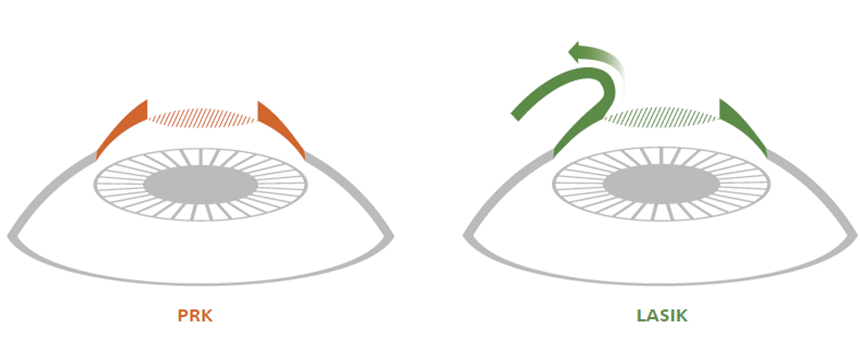PRK vs. LASIK: Which is Better in 2024?
Blurry vision is a leading concern for many individuals seeking laser vision correction, with LASIK and PRK standing out as two of the most popular options. In 2024, the National Eye Institute reports that over 150 million Americans experience blurry vision due to refractive errors—making it the most prevalent vision issue today. Common types of refractive errors include nearsightedness, farsightedness, and astigmatism.
Thankfully, modern advancements in laser vision correction have expanded your options beyond just glasses or contact lenses. With new technologies available in 2024 (such as the VISUMAX 800), it’s important to enter your doctor’s office informed about your choices, including PRK, LASIK, and even SMILE, to make the best decision for your vision correction needs.
What is LASIK?
Laser-Assisted in situ Keratomileusis (LASIK) is the more common eye surgery when comparing PRK vs. LASIK options in 2024. It, along with PRK, is a type of laser vision correction. This treatment involves creating a microscopic flap in the cornea and then reshaping the cornea with a precise beam of cool laser light. After the cornea is reshaped, the flap is replaced over the area to protect the eye’s structural integrity and promote healing.
What is PRK?
Photorefractive keratectomy (PRK) also reshapes the cornea. It does so without the flap step required for LASIK. Instead, it involves an alcohol-based fluid used to prepare the surface of the eye and a cool, pulsating laser beam of ultraviolet light. Following this treatment, a contact lens is placed on the eye to protect it, taking about a week to heal, with vision continually improving over time.
Considering PRK vs. LASIK options, How Do I Know Which Is Right For Me?
While these laser treatments are similar, PRK is often the best choice for patients with very dry eyes or thin corneas since it requires less corneal tissue than LASIK. It can be a good option for people who have had previous corrective vision treatment or older forms of vision correction such as RK (Radial Keratotomy). It can also be the right choice for those with very athletic lifestyles, emergency or military personnel, and people who work outside. However, the recovery time is slightly longer than LASIK because the eye must regrow the entire outer layer.
Is LASIK Right For Me?
LASIK is the right choice for correcting most typical vision problems like nearsightedness, farsightedness, and astigmatism. About 98% of the population find out that they’re good candidates for LASIK. LASIK provides faster recovery times with excellent visual outcomes. At the end of the day, the only person who can determine if LASIK is right for you is your ophthalmologist.
What Are The Side Effects?
PRK: The after-effects of a PRK procedure are very temporary. Some patients report feeling their eyes sore, dry, or gritty for a few days. Additionally, others may perceive halos around lights, especially in low-light contexts.
LASIK: The side effects of a LASIK procedure are very similar to a PRK procedure. Patients most often report soreness, a dry sensation, itchiness, or burning in their eyes for a day or two after the procedure. Patients can also feel an increased sensitivity to light and may see glares or halos around different light sources. These side effects almost always dissipate within a few days.
How To Prepare For LASIK or PRK in 2024
To prepare for LASIK or PRK, we recommend scheduling your free evaluation with Laser Eye Institute. During this evaluation, Dr. Dan Haddad will examine your eyes and check your vision before recommending the procedure right for you. Additionally, many patients stop wearing contacts several days before the procedure; Dr. Dan Haddad will advise you based on your contact type. Prior to the procedure, avoid applying any makeup or cream around your eyes since this can irritate your eyes during recovery. Finally, make sure you have a ride home as well, since patients will not be able to drive themselves home.
What Is Recovery Like?
When recovering from PRK, you will have a bandage contact lens on your eye, which helps heal and protect your eye from any damage. For both PRK and LASIK, you must avoid strenuous activity for approximately a week to 10 days. Patients should also use sunglasses to avoid scarring complications. LASIK patients can usually see clearly within a couple of hours while PRK patients may need more than a week to return to normal
How Much Does LASIK or PRK Cost in 2024?
Pricing for PRK and LASIK is very similar, even though PRK is a procedure that is slightly easier to perform. Laser Eye Institute offers a 24-month interest-free financing option, so it is an affordable procedure for anyone who needs it. Learn more about LASIK pricing and financing.
PRK vs. LASIK, but what about SMILE?
SMILE is another form of laser vision correction. It is even less invasive when compared to LASIK, offers faster recovery than both PRK and LASIK, and is as effective or more effective than PRK or LASIK. Most patients that are candidates for LASIK or PRK are also great candidates for SMILE.
When researching PRK vs. LASIK, know that you’ll be in excellent hands with the proven innovation and highly skilled team at the Laser Eye Institute. Schedule your free consultation today or take our LASIK quiz to see which option is right for you.
Share This Article
Posted by Dave Lemieux
David Lemieux, BA from Oakland University is a LASIK expert and marketing professional that has worked with Dr. Dan Haddad and the Laser Eye Institute since 2017. David believes in education and cutting through the noise to deliver facts and opinions about LASIK, SMILE, and all things Laser Vision Correction.
